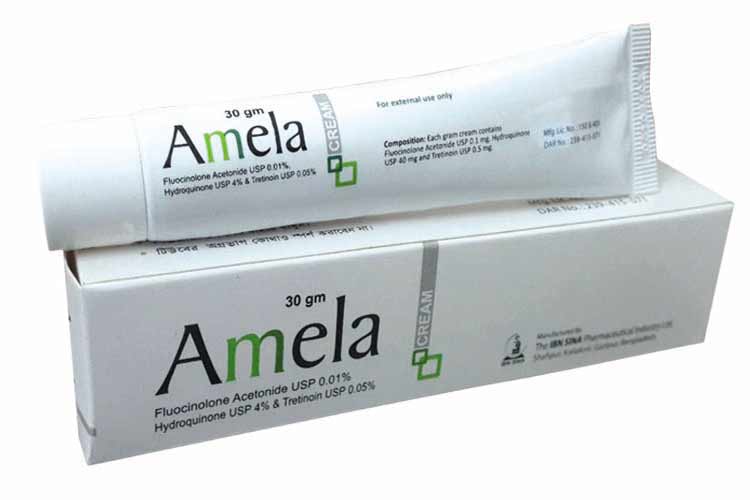
AMELA
FLUCINOLONE USP; HYDROQUINONE USP & TRETINOIN USP
| NAME | STRENGTH | PACK SIZE | DOSAGE FORM |
|---|---|---|---|
| AMELA 0.1 MG+40 MG+ 0.5 MG | 0.1 MG+40 MG+ 0.5 MG | 30 GM | CREAM |
Amela Cream: Each gram cream contains Fluocinolone Acetonide USP 0.1 mg, Hydroquinone USP 40 mg and Tretinoin USP 0.5 mg.
Fluocinolone Acetonide is a synthetic fluorinated corticosteroid that reduces inflammation.
Hydroquinone is classified therapeutically as a depigmenting agent and interrupts one or more steps in the tyrosine-tyrosinase pathway of melanin synthesis. Tretinoin is a metabolite of Vitamin A is classified therapeutically as a keratolytic. It works by increasing the skin cell turnover rate, which helps exfoliate the skin.
Amela cream is indicated for the short-term treatment of moderate to severe melasma of the face, in the presence of measures for sun avoidance, including the use of sunscreens.
Amela cream should be applied once daily at night. It should be applied at least 30 minutes before bedtime. A thin film of the cream should be applied to the hyperpigmented areas of melasma including about ½ inch of normal appearing skin surrounding each lesion. Cream is for short-term (up to 8 weeks) treatment of moderate to severe melasma of the face. It is not for long-term (more than 8 weeks) or maintenance (continuous) treatment of melasma.
Amela cream is contraindicated in individuals with a history of hypersensitivity, allergy, or intolerance to this product or any of its components.
Amela cream contains hydroquinone and tretinoin that may cause mild to moderate irritation such as skin reddening, peeling, mild burning sensation, dryness, and pruritus. Transient skin reddening or mild burning sensation does not preclude treatment. If a reaction suggests hypersensitivity or chemical irritation, the use of the medication should be discontinued.
Amela cream also contains the corticosteroid Fluocinolone acetonide. Systemic absorption of topical corticosteroids can produce reversible hypothalamic-pituitary-adrenal (HPA) axis suppression with the potential for glucocorticosteroid insufficiency after withdrawal of treatment. Manifestations of Cushing's syndrome, hyperglycemia, and glucosuria can also be produced by systemic absorption of topical corticosteroid while on treatment. If HPA axis suppression is noted, the use of AMELA cream should be discontinued.
The most frequently reported events were erythema, desquamation, burning, itching, irritation, dryness, hypopigmentation, perioral dermatitis, allergic contact dermatitis, secondary infection, and skin atrophy at the site of application. The majority of these events were mild to moderate in severity.
Pregnancy Category C. Amela cream contains the tretinoin, which may cause embryo-fetal death, altered fetal growth, congenital malformations, and potential neurologic deficits. There are no adequate and well-controlled studies in pregnant women. Amela cream should be used during pregnancy only if the potential benefit justifies the potential risk to the fetus.
It is not known whether topical application of Amela cream could result in sufficient systemic absorption to produce detectable quantities of Fluocinolone Acetonide, Hydroquinone, or Tretinoin in human milk. Because many drugs are secreted in human milk, caution should be exercised when Amela cream is administered to a nursing woman.
Patients should avoid medicated or abrasive soaps and cleansers, soaps and cosmetics with drying effects, products with high concentration of alcohol and astringent, and other irritants or keratolytic drugs while on Amela cream treatment.
Specific information not available.
Store at 20°-25°C. Do not freeze.
Amela Cream: Each tube contains 30 gm cream
